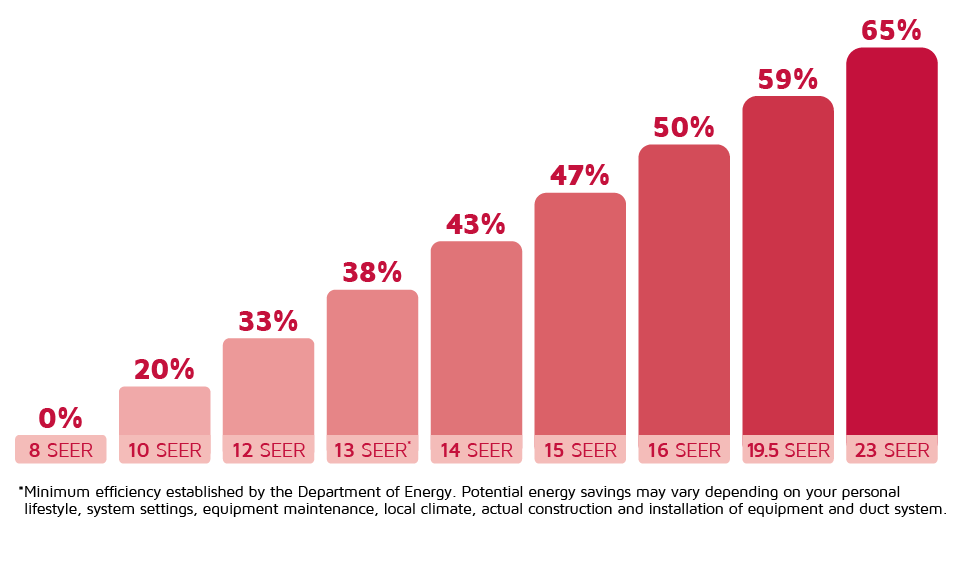What is Seer?
Simply put, this rating measures how much energy a heating and cooling system uses to operate. Learn how you can use SEER and SEER2 ratings to increase efficiency – and savings – in your home.
SEER vs SEER2
Both SEER and SEER2 are efficiency ratings that provide key insights for homeowners to compare systems from different manufacturers, or to check how efficient a given system is relative to another. The higher the SEER or SEER2 rating, the more efficient a system is.
SEER, the Seasonal Energy Efficiency Ratio, has long been the benchmark for measuring the energy efficiency of air conditioning systems. It represents the ratio of the cooling output of an air conditioner (AC) over a typical cooling season, divided by the energy it consumes in Watt-hours. Essentially, SEER was created to indicate how efficiently an HVAC system operates over an entire season.
Recently, to better accommodate new product regulations and minimum efficiency standards, the Department of Energy (DOE) introduced SEER2. SEER2 takes into account various factors that were previously overlooked in the SEER calculation, offering a more precise reflection of real-world performance. This new calculation considers cycling losses, which occur when your AC unit turns off and on repeatedly to maintain the correct temperature in your home. Each time the unit turns back on, some energy is lost restarting the system.
Though SEER2 ratings are roughly 4.5% lower than SEER, it’s important to note the increased accuracy this new rating provides.
The Benefits of a High SEER2 Rating
Choosing a high SEER rated AC unit is a smart decision for homeowners looking to save money on energy bills, reduce their environmental impact, and enhance the comfort and value of their home. They can offer a variety of benefits, including:
Increased Energy Efficiency: High SEER rated units are more energy efficient, meaning they consume less electricity to provide the same cooling output as lower SEER units. This translates to lower energy bills over time.
Cost Savings: Although high SEER units may have a higher upfront cost, the long-term savings on energy bills can often offset this initial investment. Homeowners can enjoy significant savings over the lifespan of the unit. To see how much a system with a higher SEER rating could save you, try our Energy Savings Calculator.
Environmental Impact: Lower energy consumption means reduced greenhouse gas emissions and environmental impact. Choosing a high SEER unit contributes to sustainability efforts and reduces the carbon footprint of your home.
Increased Comfort: High SEER units typically provide more consistent cooling and temperature control, leading to improved comfort levels within the home. They can maintain desired temperatures with less fluctuation, creating a more pleasant indoor environment for your family.
Long-Term Investment: HVAC systems are long-term investments in the home. Opting for a high SEER unit can increase the resale value of the property since energy efficiency is an attractive feature for potential buyers.
Government Rebates and Incentives: Many governments offer rebates, tax credits, or other incentives for installing energy-efficient appliances, including high SEER AC units. Taking advantage of these programs can further reduce the cost of upgrading to a high SEER system.

What’s a Good SEER2 Rating?
The new standards require a minimum SEER2 rating that varies depending on your type of system and location. The DOC set different minimums for the northern and southern areas of the US, due to typical air conditioning usage being higher in the south. Using the chart below, you can find your minimum efficiency standards when it comes to replacing or upgrading your existing system.
If you’re simply looking to upgrade your system, any system over 13.4 SEER2 and higher than what you currently have will prove to be more efficient. For example, even going from a 16 SEER to an 18 SEER can mean increased efficiency around 12.5%. That means for every $100 you spend to cool your home with an 18 SEER AC unit, you’ll save $12.50 more than you would have with the 16 SEER.
If you’re interested in upgrading to a more efficient system, contact your local Lennox expert for options that fit you and your home best, while meeting the minimum standards for your region.



